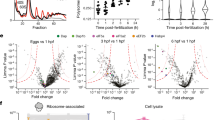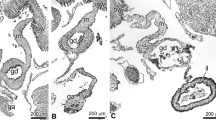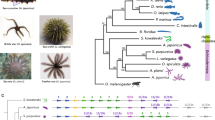Abstract
IT is well established that elongation factor 1 (EF1), the enzyme responsible for binding aminoacyl tRNA to ribosomes, exists in multiple forms in a variety of different eukaryotic tissues1–6. It is also generally accepted that in mammalian cells the heavy forms of EF1 (EF1H), with molecular weights ranging from 2×105 to >1×106, represent aggregates of a light form, with a molecular weight of ∼50,000 (refs 4 and 7). The functional significance of these findings remains unclear, since both forms are active in binding aminoacyl tRNA to ribosomes. We report here that the dehydrated gastrulae (cysts) of the brine shrimp, Artemia salina, contain almost exclusively a high molecular weight (∼250,000) form of EF1. During development of the organism EF1H seems to disappear completely so that the free swimming (hatched) embryos (nauplii) contain only a light form of the enzyme (EF1L). This change occurs at or near the time of hatching.
This is a preview of subscription content, access via your institution
Access options
Subscribe to this journal
Receive 51 print issues and online access
$199.00 per year
only $3.90 per issue
Buy this article
- Purchase on Springer Link
- Instant access to full article PDF
Prices may be subject to local taxes which are calculated during checkout
Similar content being viewed by others
References
Schneir, M., and Moldave, K., Biochim. biophys. Acta, 166, 58 (1968).
Collins, J. F., Moon, H.-M., and Maxwell, E. S., Biochemistry, 11, 4187 (1972).
Moon, H.-M., Redfield, B., Millard, S., Vane, F., and Weissbach, H., Proc. natn. Acad. Sci. U.S.A., 70, 3282 (1973).
Drews, J., Bednarik, K., and Grasmok, H., Eur. J. Biochem., 41, 217 (1974).
Golinska, B., and Legocki, A. B., Biochim. biophys. Acta, 324, 156 (1973).
Lanzani, G. A., Bollini, R., and Soffientini, A. N., Biochim. biophys. Acta, 335, 275 (1974).
Liu, C. K., Legocki, A. B., and Weissbach, H., in Lipmann Symposium (edit. by Richter, D.), 384 (de Gruyter, Berlin, 1974).
Bollini, R., Soffientini, A. N., Bertani, H., and Lanzani, G. A., Biochemistry, 13, 26 (1974).
Nombela, C., and Ochoa, S., Proc. natn. Acad. Sci. U.S.A., 70, 3556 (1973).
Lanzani, G. A., Giannattasio, M., Manzocchi, R., Bollini, A. N., and Soffientini, A. N., Biochem. biophys. Res. Commun., 58, 172 (1974).
Finamore, F. J., and Clegg, J. S., in The Cell Cycle (edit. by Padilla, G. M., Whitson, G. L., and Cameron, I. L.), 249 (Academic, New York, 1969).
Hultin, T., and Morris, J. E., Devl Biol., 17, 143 (1968).
Zasloff, M., and Ochoa, S., J. molec. Biol., 73, 65 (1973).
McClean, D. K., and Warner, A. H., Devl Biol., 24, 88 (1971).
Blumenthal, T., Landers, T. A., and Weber, K., Proc. natn. Acad. Sci. U.S.A., 69, 1313 (1972).
Author information
Authors and Affiliations
Rights and permissions
About this article
Cite this article
SLOBIN, L., MÖLLER, W. Changes in form of elongation factor during development of Artemia salina. Nature 258, 452–454 (1975). https://doi.org/10.1038/258452a0
Received:
Accepted:
Issue Date:
DOI: https://doi.org/10.1038/258452a0
This article is cited by
-
Peptide-chain elongation in eukaryotes
Molecular Biology Reports (1994)
-
Polypeptide elongation factor 1 and the control of elongation rate in rat liver in vivo
Nature (1976)
Comments
By submitting a comment you agree to abide by our Terms and Community Guidelines. If you find something abusive or that does not comply with our terms or guidelines please flag it as inappropriate.



